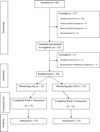A randomized study of cellphone technology to reinforce alcohol abstinence in the natural environment
- PMID: 23279560
- PMCID: PMC3662495
- DOI: 10.1111/add.12093
A randomized study of cellphone technology to reinforce alcohol abstinence in the natural environment
Abstract
Aims: Contingency management (CM) uses tangible incentives to systematically reinforce abstinence and is among the most efficacious psychosocial substance abuse treatments. This study assessed the feasibility and initial efficacy of a portable CM procedure designed to address technical limitations for detecting drinking that have prevented using CM for alcohol problems.
Design: Participants received a cellphone, breathalyzer and training on video-recording alcohol breath tests (BrACs) and texting results. For 4 weeks, staff texted participants one to three times daily indicating that a breath alcohol concentration test (BrAC) was due within the hour. Participants were randomized to (1) modest compensation for submitting dated time-stamped BrAC videos regardless of results or (2) the same plus CM with escalating vouchers for on-time alcohol-negative tests (n-BrAC; <02 g/dl). 'Thank-you' texts were sent, with CM patients also informed of results-based earnings.
Setting: Participants' natural environment.
Participants: Adults (n = 30; ≥ 21 years) who drank frequently but were not physiologically dependent.
Measurements: Drinking and related problems were assessed at intake and week 4. BrACs and self-reports of drinking were collected throughout. The primary outcome was the percentage of n-BrACs. Other outcomes were the longest duration of consecutive n-BrACs (longest duration of abstinence) and self-reports of drinking.
Findings: On average, 88.6% (10.4%) of BrACs were submitted on time, without group differences (P = 0.18). The percentage of n-BrACs and LDA were greater with CM, and there was an interaction effect on drinking frequency and negative consequences, with decreases over time with CM (P = 0.00; effect sizes d = 0.52-0.62).
Conclusion: Cellphone technology may be useful for extending contingency management to treatment for alcohol problems.
Trial registration: ClinicalTrials.gov NCT01307345.
© 2012 The Authors, Addiction © 2012 Society for the Study of Addiction.
Figures


Comment in
-
Commentary on Alessi & Petry (2013): Cellular phone technology and contingency management.Addiction. 2013 May;108(5):910-1. doi: 10.1111/add.12133. Addiction. 2013. PMID: 23587081 No abstract available.
References
-
- Mokdad A, Marks J, Stroup D, Gerberding J. Actual causes of death in the United States 2000. JAMA. 2004;291:1238–1245. - PubMed
-
- Grant BF, Dawson DA, Stinson FS, Chou SP, Dufour MC, Pickering RP. The 12-month prevalence and trends in DSM-IV alcohol abuse and dependence: United States, 1991–1992 and 2001–2002. Drug Alcohol Depend. 2004;74(3):223–234. - PubMed
-
- Substance Abuse and Mental Health Services Administration, Center for Behavioral Health Statistics and Quality. Treatment Episode Data Set (TEDS): 1998–2008. Rockville, MD: State Admissions to Substance Abuse Treatment Services; DASIS Series: S-55; 2010 HHS Publication No. (SMA) 10-4613.
-
- Treatment Episode Data Set (TEDS) SAMHSA Center for Behavioral Health Statistics and Quality. Rockville MD 2011: Drug and Alcohol Services Information System Series: S-55; 2008. Discharges from Substance Abuse TreatmentServices. DHHS Publication No.(SMA) 11-4628.
-
- Polich JM, Armor DJ, Braiker HB. The course alcoholism: of years Four treatment after treatment. New York: John Wiley & Sons; 1981. Stability and change in drinking patterns; pp. 159–200.
Publication types
MeSH terms
Associated data
Grants and funding
- R01 DA013444/DA/NIDA NIH HHS/United States
- R01-DA024667/DA/NIDA NIH HHS/United States
- P50 DA009241/DA/NIDA NIH HHS/United States
- R01 DA024667/DA/NIDA NIH HHS/United States
- P60-AA03510/AA/NIAAA NIH HHS/United States
- P60 AA003510/AA/NIAAA NIH HHS/United States
- R01HD075630/HD/NICHD NIH HHS/United States
- R01 HD075630/HD/NICHD NIH HHS/United States
- R01-DA027615/DA/NIDA NIH HHS/United States
- R01-DA13444/DA/NIDA NIH HHS/United States
- R01 DA027615/DA/NIDA NIH HHS/United States
- P50 AA003510/AA/NIAAA NIH HHS/United States
- P30-DA023918/DA/NIDA NIH HHS/United States
- R21 DA029215/DA/NIDA NIH HHS/United States
- R01 DA022739/DA/NIDA NIH HHS/United States
- R01-DA022739/DA/NIDA NIH HHS/United States
- R21-DA029215/DA/NIDA NIH HHS/United States
- P30 DA023918/DA/NIDA NIH HHS/United States
- P50-DA09241/DA/NIDA NIH HHS/United States
LinkOut - more resources
Full Text Sources
Other Literature Sources
Medical

